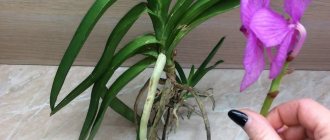Features of the flower life cycle
How to take care in autumn?
With the onset of autumn, the flower prepares to bloom. Each variety has its own duration of this period. But in most cases, orchid flowering begins in October and lasts until December or January . From the already formed peduncle, buds begin to form, and only then they fully open, showing all the beauty of the blossoming flowers.
in winter
How to care for a flower on a windowsill in winter? With the onset of winter, the plant seems to go into hibernation. This is a state of dormancy that will last until spring. This condition is typical for all orchids that grow in apartments. At this time, you should not disturb the flower again, otherwise it will not have time to fully rest, and this will negatively affect its flowering.
Flower care depending on classes
All orchids are different, what suits one may not suit another, so they need to be divided into classes and considered each separately.
These classes are as follows:
- Phalaenopsis without a pronounced dormant state.
- Orchids with pronounced dormant periods.
- Phalaenopsis with faint periods of rest.
All these orchids require special care.
Phalaenopsis without a pronounced dormant state
Flowers that belong to this category require stable care throughout the year. We are talking about lighting, temperature, watering and humidity. True, in winter there are still some nuances, which will be discussed below. This category includes the following popular orchids: paphiopedilums (slippers), phalaenopsis, miltonia.
Phalaenopsis with mild periods of rest
Such flowers do not go into hibernation. However, caring for them in winter is somewhat different than in summer. For example, fertilizing and watering are reduced. These orchids include: oncidiums, cattleya orchids, dendrobiums and laelias.
Orchids with pronounced dormant periods
Such orchids require special care with the substrate completely dry. In winter, species that belong to the presented class are not watered, the flower loses its leaves, and shoots can only be observed in spring. We are talking about tunia, calanthus, playone and several types of dendrobiums.
Step-by-step care instructions
Do I need to rearrange?
In the fall, the plant remains in the same place, but in January, when flowering is completed, it needs to be installed in a shaded room where there is no bright light. This will allow the flower to rest well and gain strength.
Is special feeding required?
In winter, the orchid is dormant, so there is no need to apply fertilizer . But to care for the month of October, fertilizing is used according to the general scheme: add nutrients every second watering.
ATTENTION : During this period, formulations with a high content of potassium and phosphorus are important.
Temperature and lighting
In winter and autumn, the optimal air temperature remains +15 degrees at night and +23 degrees during the day. Natural temperature changes of 5-7 degrees are acceptable, which will create favorable conditions for the formation of flower buds.
In October, the sun's rays will no longer burn the leaves and branches of the orchid , so you can safely keep them on windows facing south. But this light will not always be enough for full flowering. In this case, you will have to extend the daylight hours to 12 hours a day.
Lighting at home is also necessary in winter, when the plant is dormant. Its duration is also 12 hours (from 8 am to 8 pm). For this purpose, special lamps that are sold in specialized stores or ordinary fluorescent lamps are suitable.
Humidity
Humidity in winter and autumn should be maintained within 45-50% . Since heating is turned on during these periods, humidity levels drop to 20%. You can increase them by placing containers in water near the flower or spraying them with a spray bottle.
In addition, there is another interesting and effective method of increasing humidity:
- Buy transparent trays, the height of which is equal to ½ of the pot.
- Place large pebbles on the bottom of the pallets and drill several holes on the sides.
- Pour water, place a plastic lattice on top of the stones and place pots with orchids.
- Add water to the trays from time to time.
Watch a video about ways to increase humidity around orchids:
Watering
In winter, watering the flower should be reduced. Do this once every 1.5 weeks. With the onset of October, the nights are already cool, so reconsider your hydration regime. Reduce it, since the soil will now dry out more slowly. In autumn, you should not bathe the orchid or spray it generously. This can lead to the development of sad consequences. In October, water the plant once a week.
Do you need a transplant?
In winter, do not touch the orchid, so there should be no transplants . But in October you can still have time to transplant the flower into new soil, if for some reason this could not be done in the fall.
Adjusting the watering regime
In houses with central heating, warmth does not come into the apartments until early autumn. Until the batteries are turned on, the house will be quite cool. As long as the air temperature in the room is below 18 °C, orchids need to be watered less frequently. If in summer watering is carried out by soaking the pot in a container of water, then in autumn it is better to moisten the substrate by gradually pouring moisture along the edge of the container.
Before watering, inspect the orchid's roots through the walls of the pot. If the roots are green, you need to wait another 2-3 days. You can determine how dry the substrate is by the weight of the pot. The container has become light - it’s time to water the plant. It is impossible to accurately indicate the interval between waterings. This indicator depends on the temperature in the room, the characteristics of the substrate, and the condition of the plant.
4 popular orchid fertilizers for abundant flowering
How to transport in cold weather?
How to transport a flower in winter without loss? To do this, you must use the following recommendations:
At a temperature of 0 degrees, wrap the orchid in a double paper bag. If the frost is -5 degrees in winter, then for transportation, in addition to paper, you will need a plastic bag. When the frost is 7-10 degrees, a padding polyester or a laminate backing is additionally used. Wrap the flower in a paper bag with these auxiliary means and secure with a stapler.- If the frosts do not recede and the temperature is below -25 degrees, then pack the plant in a plastic bag and cover the top with padding polyethylene. Due to multilayer packaging, the effect of a thermos is created.
- Once the orchid has been delivered home, it should not be opened immediately, otherwise it will be a shock to it. Leave it wrapped for 20-30 minutes so that it has time to adapt to the new temperature.
IMPORTANT : The orchid is a very heat-loving plant, so even if it is well packaged, it is not recommended to walk with it in the cold for a long time!
Favorable days for replanting an orchid in 2022 according to the Lunar calendar
If necessary, replanting an orchid is allowed at any time of the year, if the rehabilitation period involves keeping the indoor plant under a phyto-lamp. In other cases, when agrotechnical action is not related to the condition of roots and leaves, two options are preferred:
1) transferring the planting substrate into a more beautiful pot;
2) planting in spring and summer.
The most favorable days for transplantation:
- in March -11-13, 120, 25-27;
- in April - 7-10, 12-14, 21-23, 30;
- in May -5-7, 10-12, 12-14, 18-20;
- in June -1-3, 6-8, 15-17, 28-30.
Prohibited periods:
- in March - 1, 4-6, 27-29, 31;
- in April -1-2, 23-25, 27-30;
- in May - 20-22, 25-27;
- in June -3-6, 17-19, 21-23.
Problems and difficulties
When caring for and growing orchids in winter and autumn, the following problems may arise:
- Pests. This is one of the most common problems with orchids. To solve it, it is necessary to carry out preventive measures in time, which includes frequent wiping of the leaves (5 times a day), timely replanting.
- Lack of flowering . This problem is suitable for the autumn period. In order for a plant to bloom, it needs to be provided with bright and diffused light, apply phosphorus-potassium fertilizers, create temperature indicators that will be different day and night, and provide the correct conditions.
Errors and solutions
When caring for orchids, gardeners make a number of mistakes. Because of this, the plant may get sick, stop blooming, or even die.
Let's look at the most common of them:
Incorrect watering . Very often, gardeners do not allow water to drain from the drainage hole and return the plant to its original place with a tray into which the liquid continues to flow. If the window sill is cold, then the water will take its temperature and the roots will be supercooled. This leads to the development of fungal and bacterial diseases. To prevent this problem from arising, you can lay a sheet of foam plastic on the windowsill and place an orchid on top. Polystyrene foam is a heat insulator that will prevent the water from cooling down and the roots from rotting.- Wrong place chosen . If the weather is warm in September-October, then you should not place the orchid on a south-facing window sill, otherwise this can lead to the development of burns. It is best to choose windows facing east and west.
- Heat . Orchids can be susceptible to heat stroke. This is the result of overheating of the plant due to high temperatures and humidity in a poorly ventilated room. The very first symptom is limp and soft leaves. To solve the problem, you should not place the orchid on the windowsill near heating devices in winter and autumn. To lower the temperature, you can use a fan or air conditioner. Ventilate frequently, only avoiding drafts.
- Incorrect spraying . You should not spray the flower from morning to evening. The moisture will not have time to dry out, but will begin to concentrate at the growth point and lead to rotting. Over time, the outer part of the leaves will turn yellow and fall off. To increase indoor humidity, it is better to use a humidifier.
Watch a video about errors when keeping orchids and how to solve them:
Caring for orchids with a pronounced dormant period
Flowers belonging to this class also have their own characteristics.
Tunia
With the arrival of autumn, the leaves of this species begin to turn yellow and crumble. During this period, watering begins to gradually stop. As soon as all the leaf plates have fallen off, you can forget about watering for a while. To prevent the stems from breaking off, they can be tied up. The lighting is kept bright but diffused. Temperature readings should remain at +8..+10 °C.
Pleione
This specimen does not need high temperatures, regardless of the time of year. In winter, the flower sheds all its leaves. After this happens, the plant needs to be transplanted into fresh substrate. Watering is carried out once - immediately after transplantation, which cannot be said about the lighting, which should be bright and constant. As for temperature, the ideal option is +7..+10 °C. It is not for nothing that many gardeners prefer Pleione, since caring for an orchid in winter at home is not difficult.
Kalanta
This is another species that sheds its leaves in the winter. The plant's dormant period often occurs at the end of winter. When the orchid still has flowers, it should be fed, watered abundantly and taken care of high air humidity. After flowering and leaf fall, the pot is transferred to a cool and ventilated room. The flower “rests” for about one and a half to two months. After the leaves and young shoots appear, fertilizing and watering begin.











